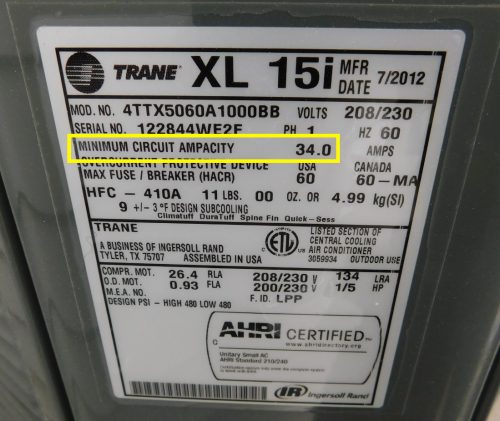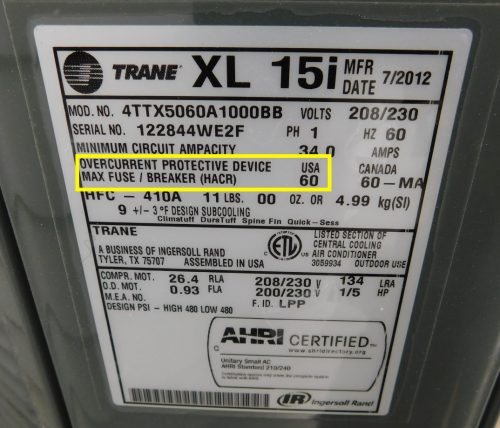One of the standard things home inspectors look at while inspecting an electrical panel is comparing wire sizes to circuit breakers sizes. When a wire is too small for a circuit breaker, you have a potential fire hazard. Circuit breakers protect the wires from overheating. While the true formula for figuring out exactly how much current a wire can carry is fairly complicated, most home inspectors rely on a simplified version of this for branch circuits:
| Breaker or Fuse (amps) | Min. copper wire size (AWG) |
| 15 | 14 |
| 20 | 12 |
| 30 | 10 |
| 40 | 8 |
| 55 | 6 |
| 70 | 4 |
For the full story, you’d have to start with table 310.15(B) (16) in the National Electric Code, but there are a ton of exceptions that make it challenging to fully figure out the exact answer. Thankfully, this simplified chart works for most of the stuff I come across as a home inspector. Wires can be larger, but not smaller than this… for the most part.
One such place where these rules for circuit breakers or fuses don’t apply is for air conditioners and heat pump circuits.
Note: while I say circuit breaker throughout this post, what I really mean is the overcurrent protection device, or OCPD. An OCPD is a generic tongue-twister for a circuit breaker or fuse.
Minimum Circuit Ampacity
For air conditioners and heat pumps, the only thing we need to look at is what’s printed on the compressor unit. These units all have a label applied to them that tells us the minimum circuit ampacity, and the maximum fuse or circuit breaker size.
The minimum circuit ampacity tells us how big the wire needs to be. I use the simplified chart above to help determine this. If the minimum circuit ampacity says 14.9 amps, we’re good with 14-gauge copper wire. If it says 15.1 amps, we need to step it up to 12-gauge copper wire. If it says 34 amps, like in the example below, we need 8-gauge wire.
Again, in the case of air conditioners, we don’t need to match up the size of the circuit breaker to the wire sizes. To paraphrase from EIOED, this is because air conditioner compressors contain thermal cutouts designed to help prevent damage to the units, and these would open before it became a problem for the wires.
The minimum circuit ampacity also tells us the minimum size of the circuit breaker; it needs to be sized large enough to help prevent nuisance tripping when the air conditioner first turns on.
Circuit Breaker Size
To determine the right circuit breaker size for an air conditioner, we look at both the minimum and maximum size allowable. The maximum size will be clearly labeled on the compressor label. In the example below, it’s 60 amps.
What’s unusual about this number on air conditioner data plates is that it often doesn’t jive with the chart I listed above. I mentioned that the minimum wire size for this air conditioner would have to be 8-gauge, and a 60-amp circuit breaker would normally be too large for that size wire… but it doesn’t matter. It’s ok for this to happen here.
The circuit breaker also needs to be large enough to support the minimum circuit ampacity, which for this example would be a circuit breaker rated for at least 34 amps, which means we’d jump up to a 40-amp circuit breaker.
The most common defect that we find is an oversized circuit breaker. This typically happens because an air conditioner is replaced with a more efficient unit, but the circuit breaker in the panel is not replaced with a smaller one. If the electrical disconnect at the exterior has fuses that are sized appropriately, however, then it would be acceptable to have a circuit breaker that is oversized.
Summary
For air conditioners and heat pumps, we size the wires and circuit breakers in accordance with the information printed on the label, not the simplified sizing charts that we typically rely on.




Hank Spinnler
May 5, 2020, 7:28 am
Good technical article. I would like to add our experience to your statement “The most common defect that we find is an oversized circuit breaker. Thich typically happens because an air conditioner is replaced with a more efficient unit, but the circuit breaker in the panel is not replaced with a smaller one.”
In new construction, the electrician arrives first and installs the circuit breakers before the HVAC installation company installs the AC or heat pump units. Evidence shows that they “guesstimate” what size breakers may be needed without consulting with the HVAC company. They will often put two of the same ampacity breakers in the panel. For example, they might install (2) – 30 Amp circuit breakers when one AC unit has a 20 Amp maximum rating and the other unit has a 30 Amp maximum rating.
EsP
May 22, 2020, 11:58 pm
Based on the name plate data, this particular Trane air conditioning unit should have a 40 AMP circuit breaker installed with 8 gauge wire wired to the air conditioning unit?
Reuben Saltzman
May 23, 2020, 4:54 am
A 40 would be fine, a 60 would be fine, and anything in the middle would be fine.